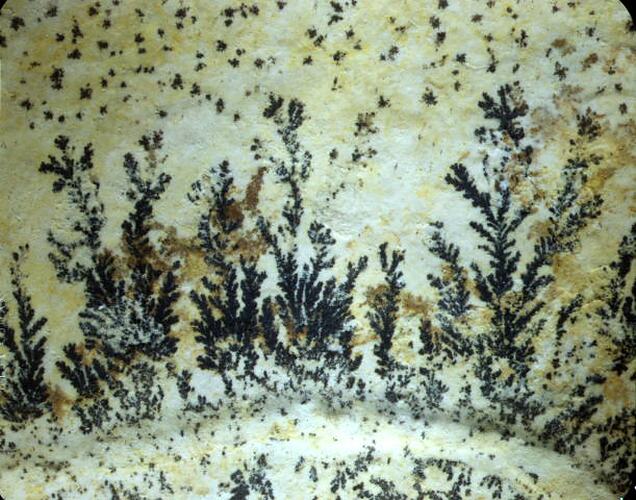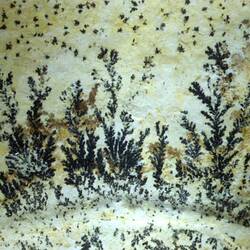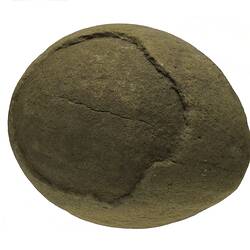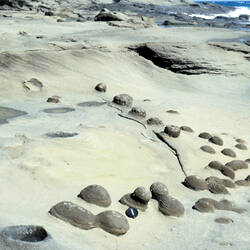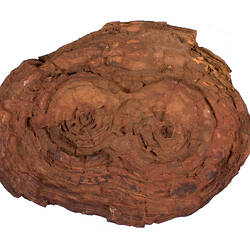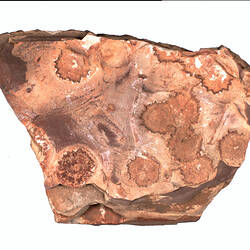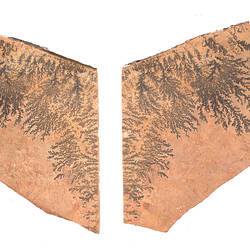Because of the myriad of forms taken by animals and plants, fossils come in countless shapes and sizes. Nearly all of these can be easily recognised, but because Nature is a great imitator, there are several types of rock and mineral structures which are commonly mistaken for fossils. The most common of these 'pseudofossils' are concretions, nodules and dendrites, which mostly form during weathering of sedimentary rocks of different types. Pseudofossils lack the internal structure of bone or wood.
While it is always best to take any very unusual rocks to a museum for identification, commonsense by the finder usually allows the fake fossil to be distinguished from the real thing.
Ironstone concretions
Concretions consisting of concentric layers of dark brown iron oxide deposited around a nucleus are amongst the most common type. Removal of the nucleus in some way can result in the concretion being hollow. This type of concretion forms during weathering of sedimentary rocks, such as sandstones, that contain large amounts of iron. In some sandstone, pyrite (iron sulphide) may form part of the cement which binds the sand grains together. When the rock starts to weather, groundwater moving through the pore spaces begins to breaks down the pyrite. A spherical shell of iron oxide is precipitated around any remaining pyrite. If this process continues, the result can be a hard shell surrounding a hollow core that contains some powdery grains of sand. Ironstone concretions are common around Melbourne, where they have been eroded from sedimentary rocks around the coast of Port Phillip Bay. Wave action has concentrated them on some beaches and has also given them a natural polished appearance.
Cannonball concretions
These unusual concretions are named for their obvious resemblance to cannonballs. In Victoria they are particularly prominent on the shore platforms around the Otway Ranges coastline, southwest of Melbourne. The host rocks for these concretions are sandstones that are about 130 million years old and contain abundant grains of feldspar rather than quartz. Amongst the various minerals cementing the feldspar grains together are zeolites, chlorite and carbonates. In cannonball concretions, the cement consists of carbonate minerals such as calcite, ankerite and siderite, which offer more resistance to abrasion by wave action than softer cementing minerals. Not all the concretions are spherical; others take a variety of rounded shapes and may be several metres across. These concretions formed soon after the sandstones were laid down and have been exposed by erosion.
Dune concretions
Commonly scattered over the surfaces of coastal sand dunes in Victoria are hard pieces of cemented sand grains which resemble pieces of bone or fossilised tree roots. These are a form of concretion which results from percolation of groundwater along tubular channels in the dunes, probably occupied by plant roots. If the groundwater contains dissolved carbonate minerals, these may precipitate around the tube, helping to cement the surrounding sand grains. Sifting of the loose grains of the dune by wind gradually concentrates these tubular concretions on the surface.
Septarian concretions
These are rounded concretions or nodules that show two series of intersecting cracks, one concentric, the other radial. These give the concretion a 'turtle-back' appearance. In septarian concretions, the original cementing mineral was clay, which contains water. Later dehydration caused the clay to shrink and the concretion to crack. Another mineral such as quartz or calcite commonly crystallises in the cracks. Septarian concretions are not as common as the other types in Victoria.
Dendrites
Dendrites are delicately branched deposits of black minerals (typically manganese oxides) that have been precipitated from water seeping through fractures in fine-grained rocks. While their close resemblance to fossilised fern fronds can have great aesthetic appeal, dendrites are much less regular than plant fossils and lack features such as vein structures. Although not common, some good examples of dendrites occur in fine-grained volcanic rocks in the Lilydale district, east of Melbourne.
Odd-shaped rocks
Smooth pebbles and other rocks that have been shaped by erosion may take on shapes resembling whole or parts of fossilised animals. Patterns of indentations in the surface of some rocks may resemble imprints of fingers or toes.
More Information
-
Keywords
-
Localities
-
Authors
-
Article types
